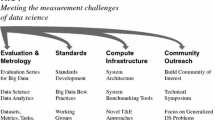Abstract
Recently, research facilities in academia take on a crucial role in the innovation ecosystem where facilities are promoting research collaborations through shared use with other research organizations, academia, and firms. We focus on the remote operation of measurement methods and speed-up technologies as a countermeasure against COVID-19 setback, whereby face-to-face contact and interactions are restricted, thus making it impractical for users to visit and use research facilities. We discuss how these new technologies and methodologies promote and obstruct industry-academia research collaborations during the post-corona period. Specifically, the focus is on NMR (Nuclear Magnetic Resonance Device), a state-of-the-art research facility that promotes shared use to external users in Japanese academic research institutes.
Access this chapter
Tax calculation will be finalised at checkout
Purchases are for personal use only
Similar content being viewed by others
References
Liu, T.-H.: The philosophical views of national innovation system: the LED industry in Taiwan. Asia Pac. Manag. Rev. 24, 291–297 (2018)
Schot, J., Steinmueller, W.E.: Three frames for innovation policy: R&D, systems of innovation and transformative change. Res. Policy 47, 1554–1567 (2018)
Soete, L.: Science, technology and innovation studies at a crossroad: SPRU as case study. Res. Policy 48, 849–857 (2019)
Cirillo, V., et al.: Only one way to skin a cat? Heterogeneity and equifinality in European national innovation systems. Res. Policy 48, 905–922 (2019)
Ravetz, J.: The No-Nonsense Guide to Science. New Internationalist, Oxford (2006)
Stokes, D.E.: Pasteurs Quadrant: Basic Science and Technological Innovation. Brookings Institution Press, Washington, DC (1997)
Rosenbloom, R.S., Spencer, W.J.: Engines of Innovation: U.S. Industrial Research at the End of an Era. Harvard Business School Press, Cambridge (1996)
Ziman, J.M. (ed.): Prometheus Bound: Science in a Dynamic “Steady State.” Cambridge University Press, Cambridge (1994)
Gibbons, M., et al.: The New Production of Knowledge: The Dynamics of Science and Research in Contemporary Societies. SAGE, London (1994)
Etzkowitz, H.: The Triple Helix: University-Industry-Government Innovation in Action. Routledge, London (2008)
Riesener, M., et al.: Innovation ecosystems for industrial sustainability. Procedia CIRP 80, 27–32 (2019)
Sun, S.L., et al.: Enriching innovation ecosystems: the role of government in a university science park. Glob. Transit. 1, 104–119 (2019)
Arundel, A., et al.: Advancing innovation in the public sector: aligning innovation measurement with policy goals. Res. Policy 48, 78–798 (2019)
OECD/Eurostat: Oslo Manual Guidelines for Collecting and Interpreting Innovation Data, Paris (2005)
Autio, E., et al.: A framework of industrial knowledge spillovers in big-science centers. Res. Policy 33, 107–126 (2004)
Japanese Council for Science and Technology: ‘Leading in the New System of Research Equipment and Machines for Shared and core Combined by the Management in Research Organization’ (2015)
Cabinet Office Government of Japan: Comprehensive Strategy on STI 2014 (executive summary), Science and Technology Policy Council for Science, Technology and Innovation (2014)
Haley, R.: A framework for managing core facilities within the research enterprise. J. Biomol. Tech. 20, 226–230 (2009)
Farber, G.K., Weiss, L.: Core facilities: maximizing the return on investment. Sci. Transl. Med. 3, 1–4 (2011)
Hockberger, P., Meyn, S., Nicklin, C., et al.: Best practices for core facilities: handling external customers. J. Biomol. Tech. 24, 87–97 (2013)
Lozano, S., Rodríguez, X.-P.: Arenas A, Atapuerca: evolution of scientific collaboration in an emergent large-scale research infrastructure. Scientometrics 98, 1505–1520 (2014)
Wuchty, S., Jones, B.F., Uzzi, B.: The increasing dominance of teams in production of knowledge. Science 316, 1036–1039 (2007)
von Hippel, E.: The dominant role of users in the scientific instrument innovation process. Res. Policy 5, 212–239 (1976)
Prahalad, C.K., Ramaswamy, V.: The Future of Competition: Co-Creating Unique Value with Customers. Harvard Business Review Press, Cambridge (2004)
Vargo, S.L., Lusch, R.F.: Service-dominant logic: continuing the evolution. J. Acad. Mark. Sci. 36, 1–10 (2008)
Knorr-Cetina, K.D.: Epistemic Cultures: How the Sciences Make Knowledge. Harvard University Press, Cambridge (1999)
Brosnan, C.: Epistemic cultures in complementary medicine: knowledge-making in university departments of osteopathy and Chinese medicine. Health Sociol. Rev. 25, 171–186 (2016)
Mørk, B.E., Aanestad, M., Hanseth, O., Grisot, M.: Conflicting epistemic cultures and obstacles for learning across communities of practice. Knowl. Process Manag. 15, 12–23 (2008)
Kasperowski, D., Hillman, T.: The epistemic culture in an online citizen science project: programs, antiprograms and epistemic subjects. Soc. Stud. Sci. 48, 564–588 (2018)
Acknowledgments
We have had a lot of support and encouragement from directors, scientists, coordinators, and technicians in the NMR facility at RIKEN.
Author information
Authors and Affiliations
Corresponding author
Editor information
Editors and Affiliations
Rights and permissions
Copyright information
© 2021 The Author(s), under exclusive license to Springer Nature Switzerland AG
About this paper
Cite this paper
Onoda, T., Ito, Y. (2021). Industry-Academia Research Collaborations in the Post-corona Era: A Case Study of Remote Operations in a Japanese State-of-the-Art Research Facility. In: Leitner, C., Ganz, W., Satterfield, D., Bassano, C. (eds) Advances in the Human Side of Service Engineering. AHFE 2021. Lecture Notes in Networks and Systems, vol 266. Springer, Cham. https://doi.org/10.1007/978-3-030-80840-2_50
Download citation
DOI: https://doi.org/10.1007/978-3-030-80840-2_50
Published:
Publisher Name: Springer, Cham
Print ISBN: 978-3-030-80839-6
Online ISBN: 978-3-030-80840-2
eBook Packages: EngineeringEngineering (R0)




